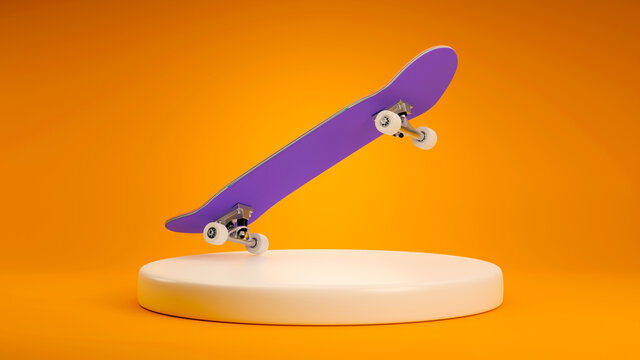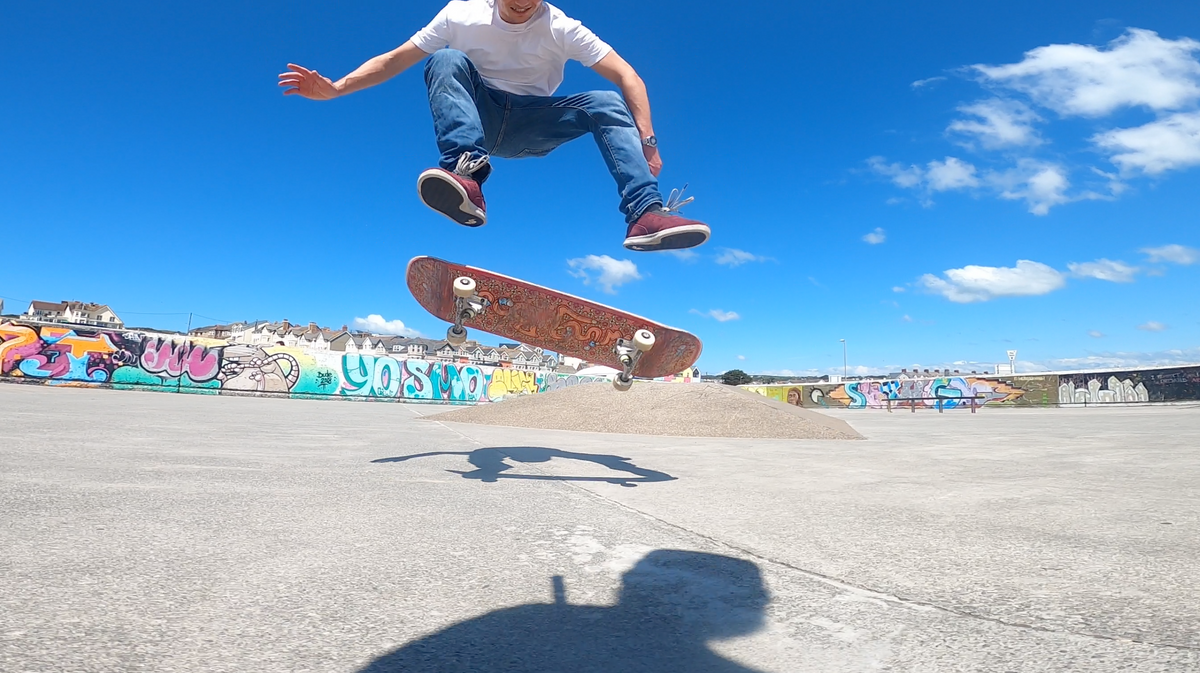The Art and Evolution of Skateboarding
Dive into the dynamic world of skateboarding, from its roots in Southern California to its global influence today. Uncover the components of a skateboard, explore diverse skating styles such as street, vert, and park, and delve into the rich culture that transcends sport. This is not just about tricks and flips; it's a lifestyle, an art form, and a global community united by the thrill of the ride on four wheels.
Skateboarding: A Dynamic Cultural Phenomenon

Skateboarding, with its roots deeply embedded in the streets and counterculture, has transformed from a niche hobby to a global phenomenon. It is not merely a sport on four wheels; rather, it is a dynamic and ever-evolving cultural expression. This 1000-word exploration delves into the history, components, and significance of skateboarding, capturing the essence of this exhilarating and rebellious activity.
Historical Roots: From Surf to Street
Skateboarding's origins can be traced back to the surf culture of Southern California in the 1940s and 1950s. When the waves were flat, surfers sought alternative ways to experience the thrill of riding. Inspired by the fluid movements of surfing, they attached roller skate wheels to a board, creating the first rudimentary skateboards. These early skateboards were simple planks of wood with clay or metal wheels, offering a makeshift surfing experience on land.
The popularity of skateboarding surged in the 1960s as manufacturers began producing purpose-built skateboards with improved materials and designs. However, it wasn't until the 1970s that skateboarding truly exploded onto the cultural scene. The Zephyr Skate Team, known as the Z-Boys, played a pivotal role in shaping skateboarding's trajectory. Hailing from Dogtown, a neighborhood in Santa Monica, California, the Z-Boys, led by figures like Stacy Peralta and Tony Alva, revolutionized skateboarding with their aggressive and fluid style. The Z-Boys embraced empty swimming pools, drainage ditches, and urban landscapes, turning them into their own concrete canvases.
Components of a Skateboard: Crafting the Ride
Understanding the anatomy of a skateboard is crucial to comprehending its functionality and the rider's experience. A typical skateboard comprises several key components:
- Deck: The deck is the flat board that riders stand on. Usually made of seven layers of maple wood, the deck's dimensions vary, catering to different styles of skateboarding. Modern decks often feature graphic designs, reflecting the rider's personality or the brand's aesthetics.
- Trucks: Positioned under the deck, trucks are metal T-shaped components that hold the wheels. They consist of a baseplate, kingpin, bushings, and hanger. Trucks play a vital role in steering, stability, and grind capabilities.
- Wheels: The wheels are made of urethane and come in various sizes and hardness levels. Smaller, harder wheels are suitable for street skating, providing speed and durability, while larger, softer wheels offer better grip and shock absorption, ideal for cruising or downhill riding.
- Bearings: Bearings enable the wheels to spin smoothly. High-quality bearings reduce friction, enhancing the skateboard's overall performance.
- Grip Tape: The top surface of the deck is covered with grip tape, a sandpaper-like material. It provides traction, allowing the rider to maintain control during tricks and maneuvers.
- Hardware: Bolts and nuts secure the trucks to the deck, holding the skateboard together. While seemingly mundane, hardware is crucial for maintaining the board's structural integrity.
- Risers: These small plastic or rubber pads are placed between the deck and trucks. Risers absorb shock and prevent wheel bite, enhancing the skateboard's stability.Understanding how these components interact is essential for skateboarders as they tailor their setups to match their riding style and preferences.

Cultural Impact: Beyond Sport
Skateboarding has transcended its status as a sport and become a cultural force with a global impact. At its core, skateboarding embodies a spirit of rebellion, individualism, and creativity. The act of propelling oneself forward on a skateboard is a form of self-expression, a dance between the rider and the urban landscape.
One cannot overlook the influence of skateboarding on fashion, music, and art. Skate culture has birthed its own unique aesthetic, with skaters often being trendsetters in streetwear. Brands like Vans and Supreme have roots in skate culture, and the distinctive styles associated with skateboarding have permeated mainstream fashion.
The relationship between skateboarding and music is symbiotic. Punk, hip-hop, and alternative genres have embraced skate culture, and many skaters find inspiration in the beats that accompany their rides. Iconic skate videos often feature soundtracks that become anthems for skateboarders worldwide, creating a sonic backdrop to their rebellious pursuits.
Furthermore, the art world has been significantly influenced by skateboarding. Skateboard graphics, a form of mobile art, often showcase the creativity of both established and emerging artists. From intricate designs to thought-provoking illustrations, skateboard decks serve as canvases that reflect the diverse perspectives within the skateboarding community.
Evolution and Diversity: Styles of Skateboarding
Skateboarding is not a monolithic activity; it encompasses a variety of styles and disciplines. Understanding these styles provides insight into the diverse nature of skateboarding and the range of skills exhibited by its practitioners:
- Street Skateboarding: Perhaps the most popular style, street skateboarding involves performing tricks and maneuvers in urban environments. Stairs, handrails, ledges, and skate parks become the playground for street skaters, who master techniques like kickflips, grinds, and ollies.
- Vert Skateboarding: Vert, short for vertical, involves riding ramps, halfpipes, and bowls. Skaters drop in from the top and perform aerial tricks, showcasing a combination of skill, balance, and fearlessness.
- Park Skateboarding: Similar to vert but often incorporating a wider range of obstacles, park skateboarding takes place in purpose-built skate parks. These parks feature bowls, ramps, rails, and other structures, allowing skaters to explore their creativity in a controlled environment.
- Cruising and Longboarding: Not all skateboarding is about tricks and flips. Cruising and longboarding focus on the joy of riding, with skaters covering long distances and navigating hills. Longboards, with their larger decks and softer wheels, provide a smoother and more stable ride.
- Freestyle Skateboarding: Freestyle involves a combination of fluid movements, technical footwork, and creative expression. While not as prominent as other styles, freestyle showcases the artistic side of skateboarding. Each style requires a unique set of skills and equipment, contributing to the diverse and inclusive nature of the skateboarding community.
Challenges and Controversies: The Skateboarding Landscape
While skateboarding has gained widespread acceptance, it has not been without its share of challenges and controversies. Historically, skateboarding faced stigma, with some viewing it as a rebellious and destructive activity. Skaters often encountered opposition from law enforcement and property owners, as the act of grinding ledges, handrails, and curbs could be perceived as vandalism.
However, the perception of skateboarding has shifted over the years. Cities worldwide are recognizing the positive impact of skate parks in providing safe spaces for skaters to practice their craft. The inclusion of skateboarding in the Olympic Games has also contributed to its mainstream acceptance, though this move has sparked debates within the skateboarding community regarding its commercialization and potential dilution of its rebellious spirit.
As skateboarding navigates its path within mainstream culture, it grapples with maintaining its authenticity and subversive roots. The tension between being recognized as a legitimate sport and preserving its countercultural identity is an ongoing conversation within the community.
Types of Skateboard and Its Durability
Skateboards come in various types, each designed for specific styles of riding and skill levels. The durability of a skateboard is influenced by factors such as the quality of materials, construction methods, and intended use. Here are some common types of skateboards and insights into their durability:
- Street Skateboards:
- Type: Street skateboards are the most common type, designed for tricks and maneuvers on urban landscapes. They typically have a concave deck for better control during flip tricks.
- Durability: Street skateboards are built for durability, often featuring sturdy seven-ply maple decks. The durability also depends on the quality of the trucks, wheels, and bearings.
- Cruiser Skateboards:
- Type: Cruiser skateboards are designed for smooth rides and transportation over short distances. They usually have a more relaxed shape and larger, softer wheels.
- Durability: Cruisers are often durable, with a focus on a smooth ride. The deck material and overall construction contribute to their ability to withstand the impact of cruising over various terrains.
- Longboards:
- Type: Longboards are longer and wider than traditional skateboards, emphasizing stability at higher speeds. They are often used for downhill riding and commuting.
- Durability: Longboards are generally durable, featuring flexible bamboo or sturdy maple decks. The durability is enhanced by the larger wheel size and softer wheels, which absorb shocks during long rides.
- Old School Skateboards:
- Type: Old school or retro skateboards have a design reminiscent of boards from the 1970s and 1980s. They are often wider with a flat nose and kicktail.
- Durability: The durability of old school skateboards depends on the quality of materials used in their construction. They are typically built with the same durability standards as modern street skateboards.
- Electric Skateboards:
- Type: Electric skateboards are motorized and controlled by a handheld remote. They are used for commuting and can reach higher speeds than traditional skateboards.
- Durability: The durability of electric skateboards depends on both the skateboard components and the electric motor system. High-quality electric skateboards are designed to withstand the additional stresses of motorized propulsion.
- Pool/Vert Skateboards:
- Type: Pool or vert skateboards are designed for riding in skateparks, bowls, and vertical structures. They often have a wider deck and larger, softer wheels.
- Durability: These skateboards are built for durability to withstand the impact of aerial tricks and riding in transition-heavy terrain. The deck, trucks, and wheels contribute to their overall robustness.
Factors Affecting Durability:
- Deck Material: The most common material for skateboard decks is maple wood, usually seven-ply. Higher quality decks may use additional materials like bamboo or carbon fiber for added strength and flexibility.
- Trucks: Durable trucks are crucial for the overall stability and performance of a skateboard. High-quality metal trucks with sturdy construction contribute to the durability of the board.
- Wheels: Wheel composition and hardness affect durability. Softer wheels provide a smoother ride and better grip but may wear out faster. Harder wheels are more durable but can be less forgiving on rough terrain.
- Bearings: High-quality bearings contribute to the smoothness and overall durability of the skateboard. Well-maintained bearings ensure a smoother ride and reduce wear on wheels.
In summary, the durability of a skateboard is influenced by the type of skateboard, the quality of its components, and how well it is maintained. Investing in a skateboard from reputable brands and regularly maintaining its components can significantly extend its lifespan and performance.
The Global Community: Connecting Through Concrete
Skateboarding is a language that transcends borders. The global skateboarding community is a vibrant and interconnected network of individuals who share a passion for rolling on four wheels. Social media platforms and online forums have played a pivotal role in connecting skaters worldwide, allowing them to share tricks, discuss gear, and celebrate the art of skateboarding.
Local scenes and skateboarding cultures have emerged in cities across the globe, each with its own unique flavor. From the bustling streets of Tokyo to the sun-soaked skate parks of Barcelona, the universal language of skateboarding unites people from diverse backgrounds and cultures. Skateboarding has become a form of expression for marginalized communities, providing a platform for individuals to tell their stories and challenge societal norms.
The sense of camaraderie within the skateboarding community is palpable. Skateboarders support one another, whether it's cheering for a friend landing a challenging trick or offering advice to a newcomer. The inclusive nature of skateboarding fosters a sense of belonging, breaking down barriers and welcoming anyone with a passion for the board.

Frequently Asked Questions
Meaning of Playing Skateboard:
Playing skateboard refers to the act of riding and performing tricks on a skateboard. It involves a combination of balance, skill, and creativity as individuals navigate urban landscapes, skate parks, or other suitable terrains. Skateboarding is not just a physical activity; it is often seen as a form of self-expression and a way to connect with a vibrant global community.
Best Definition of Skateboard:
A skateboard is a narrow board mounted on four wheels and designed for the sport or activity of skateboarding. Comprising a deck, trucks, wheels, and bearings, a skateboard is a versatile piece of equipment used for various styles of skating, including street, vert, and park. It serves as a means of transportation, a tool for performing tricks, and a symbol of the rebellious spirit within skate culture.
Good Sentence for Skateboard:
"He effortlessly glided down the city streets, executing impressive tricks on his skateboard, a testament to his skill and the freedom that comes with mastering the art of skating."
Preventing Skateboarding Injuries:
- Protective Gear: Always wear appropriate protective gear, including a helmet, knee pads, elbow pads, and wrist guards to minimize the risk of injury in case of falls.
- Learn Proper Technique: Take the time to learn and practice fundamental skateboarding techniques to enhance control and reduce the likelihood of accidents.
- Choose Suitable Terrain: Skate in designated areas such as skate parks or smooth, well-maintained surfaces to minimize potential hazards.
- Inspect Your Equipment: Regularly check your skateboard for any wear and tear, ensuring that all components are in good condition to prevent equipment failure during use.
- Warm-up Exercises: Perform warm-up exercises before skateboarding to prepare your muscles and joints, reducing the risk of strains and sprains.
Skateboard Price:
The price of a skateboard can vary widely based on factors such as brand, quality, and features. Entry-level skateboards for beginners may range from $50 to $100, while professional-grade or specialty boards can cost upwards of $200 or more.
Skateboard Price in Nigeria:
Skateboard prices in Nigeria can vary based on availability and brand. Entry-level skateboards may be priced between 20,000 and 40,000 Naira, while higher-end or imported models could be priced higher.
Skateboard Electric:
An electric skateboard is a motorized version of a traditional skateboard, equipped with an electric motor that allows riders to travel at varying speeds without manually pushing. These boards often come with remote controls for speed adjustment and braking.
Skateboard for Kids:
Skateboards designed for kids typically have smaller decks and softer wheels, providing better stability and control for younger riders. It's essential to ensure that the skateboard is appropriate for the child's age and skill level, and that they wear appropriate safety gear.
Skateboard Meaning:
The term "skateboard" refers to a recreational device consisting of a board with four wheels, designed for the sport or activity of skateboarding. Beyond its literal definition, the skateboard carries cultural significance, symbolizing a lifestyle of freedom, creativity, and rebellion.
How Much is Skateboard in Shoprite:
The price of a skateboard in Shoprite, or any other store, can vary based on the brand and quality of the skateboard. It's advisable to check the specific Shoprite location or their online platform for the current prices and available options.
Skateboard for Adults:
Skateboards for adults come in various styles, catering to different preferences and skill levels. Adult-sized boards typically have wider decks and larger wheels to provide stability and a comfortable riding experience for older users. Choosing the right skateboard depends on the individual's skill level, intended use, and personal preferences.
Skateboard Jiji:
Jiji is a popular online marketplace, and it may have listings for skateboards. If you're interested in purchasing a skateboard on Jiji, be sure to check the product details, reviews, and communicate with the seller to ensure you're getting a suitable and reliable skateboard.
The Thrill of the Push
In conclusion, skateboarding is more than just a sport; it is a multifaceted cultural phenomenon that continues to evolve and captivate generations. From its humble beginnings on the streets of Southern California to its global influence today, skateboarding has left an indelible mark on the worlds of sports, fashion, music, and art.
The beauty of skateboarding lies in its simplicity and complexity simultaneously. It's a solo pursuit that thrives on community, a rebellious act that seeks acceptance, and a physical activity that transcends the boundaries of age and background. Skateboarding is a form of self-expression, an art form, a lifestyle, and a global language spoken by those who find freedom and joy on a wooden deck with four wheels.
As skateboarding continues to ride the waves of mainstream recognition, its community must grapple with the delicate balance of preserving its subversive roots while embracing the opportunities that come with widespread acceptance. The wheels keep turning, and as long as there are streets to ride, obstacles to conquer, and a sense of rebellion in the air, skateboarding will remain an enduring and influential force in the cultural landscape.




